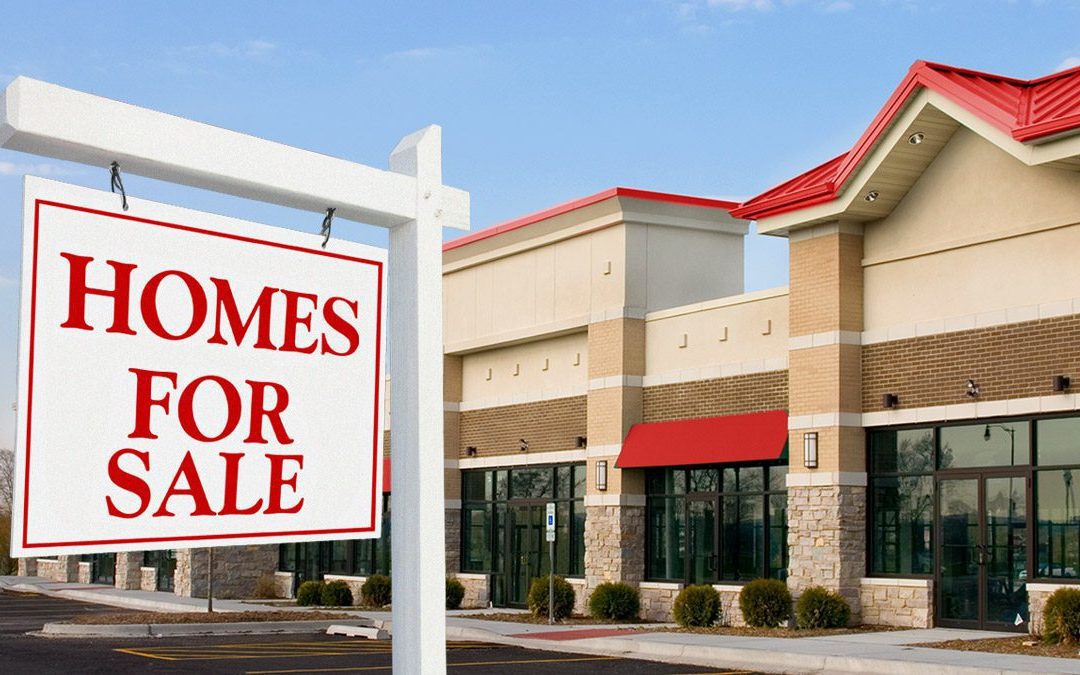Would You Call a HomeGoods Store Home? The Future of Housing Might Be at Your Local Mall: Massachusetts HomeBuyers HomeOwnerhsip
Remember that coral floor pouf you bought for a song at HomeGoods a few months back? Well, one day it might be brightening the living room of your new home in a former HomeGoods store (maybe around aisle 5?). Yes, really. Your next home, sweet home, may just be down the street at your local mall in one of your favorite retail therapy spaces. Americans are facing a tight housing market with low inventory.
Combine this housing crunch with the national median list price a whopping four hundred and five thousand dollars and the shortage of affordable housing, and the question becomes: What’s a desperate homebuyer to do? For some cities and developers, the answer is to convert vacant retail and office space into housing. With a national decline in retailing, and many shopping malls filled with vacancies, this move seems to make sense all around. Indeed, many cities across the United States are already in the middle of giving big box shoppers a new product to obsess over: homes.
Currently, two former Kmart stores are slated for conversion. In Milford, CT, the city’s planning board recently approved a multifamily housing project at the former retail chain site. And developers in Bloomington, IN, are turning another former Kmart store into an $80 million housing complex that will include housing for students at nearby Indiana University. Some cities are even restoring the homes that were originally demolished to make room for now-shuttered businesses. For instance, in Dayton, OH, the city plans to redevelop a U.S. Bank site back into the exact housing that was previously located on the site.
“The affordability crisis and other real estate uncertainties are heating up the real estate industry day by day,” says Dustin Fox, a real estate agent and owner of Fox Homes, which serves Washington, DC; Virginia; and Maryland. “With big-box stores such as Macy’s, JCPenney, Sears, etc. closing in record numbers, repurposing those vacant spaces has become necessary.” But will people want to live in the former shoe section of a department store? Let’s take a look at the five pros and one con to calling a former HomeGoods store home.
Pro: Affordable housing
In an effort to meet regional and state affordable housing goals, these new housing developments usually set aside a certain number of units as affordable housing. For example, the project in Milford plans to designate ten percent of the dwelling units as affordable, which is required by the state’s 8-30g statute. While cities and states might vary in how they define “affordable,” most affordable housing is determined by the local median household income.
And generally, housing is deemed affordable if no more than thirty percent of that income goes to yearly home costs. In Milford, the median household income is $95,785, and thirty percent of that works out to twenty eight thousand seven hundred and thirty five dollars a year, or two thousand three hundred ninety four dollars and sixty two cents a month. And with the housing shortage stretching across the country, many cities and states are working to address the lack of affordable housing through retail to housing conversions. To wit, California is considering a bill that would make it the first state to provide incentives to cities that turn vacated retail space into affordable workforce housing.
Pro: Prime locations
Former retail centers are often located in central areas near existing infrastructure such as roads, urban centers, and residential clusters, says Ileana Schneider, an architect and author from Washington, DC.
So for those who choose to live in multifamily, mixed use developments, living in a former retail space offers the opportunity to live close to where they shop or enjoy entertainment outlets. And then there’s the walkability factor, which is usually a huge selling point for those who choose to live in these converted spaces.
Pro: Neighborhood revitalization
Abandoned shopping centers, strip malls, and big box stores are known as “greyfield sites.” And redeveloping these sites can contribute to community renewal. Not only can paved lots be reallocated to green space, but renewed greyfield sites also generally boost local employment and increase retail demand in the surrounding area.
“The extensive footprint that allowed for parking for thousands of cars can be converted into an urban grid with diverse density options, from townhouses to high rises,” says Schneider. And repurposing a sizable concrete pad of retail space into a mixed-use development is “a more environmentally sustainable option that avoids demolition waste and carbon emissions,” according to the Department of Housing and Urban Development.
Pro: Homebuyer relief
With home prices soaring across the U.S., moving into a high-density housing community can be a more affordable option for weary homebuyers. “High-density housing communities can offer a cheaper alternative,” says Anthony Minniti, a professional homebuyer in Tyler, TX. “On average, a three bedroom apartment in these former retail communities can be bought for a quarter of the price of a three bedroom house in a low density neighborhood.”
So, for some first-time homebuyers, high density housing may be the only way to enter the market. In addition to the lower price tag, buyers aren’t entirely on their own when it comes to maintenance and repairs. Instead, the development’s homeowners association fees usually cover those costs. Another bonus is the amenities that often come with these development communities, including walking and bike paths, community fitness centers, and close proximity to retail and restaurants.
Con: High density
The same reason these developments are a great option mixed use, walkability, and nearby retail can often be a con for some buyers. To keep prices low, retail to home developments generally have many units, which means more neighbors and more cars in the area. And the nature of these developments translates into a more urban feel, which may turn off some buyers.
“The benefits of high-density development come with an expected caveat: traffic,” says Joshua Blackburn, founder and director of design and construction at Evolving Home. “Traffic congestion is a given wherever the population is concentrated. As a result, public transportation and the walkability of housing must be meticulously planned to skirt traffic problems in a high density community.”
The success of turning retail into housing
Whether you want a home on the range or a unit in a former mall, many cities have successfully converted formerly underused retail space into thriving downtown mixed use neighborhoods. In Lakewood, CO, city officials partnered with developers to convert a giant indoor mall in the heart of the city into a 22-block walkable development called Belmar, which includes restaurants, retail, specialty shops, and apartments and condos for two thousand residents. (A one-bedroom unit at the Cortland Belmar apartments starts at one thousand seven hundred and seven dollars a month.)
Bottom line: As buildable land grows ever scarcer and cities struggle to meet affordable housing requirements, more municipalities across the country will look to the tired and underused retail space for tomorrow’s housing. And so, you never know. One day you might be sleeping where shoppers once searched for home goods and housewares.
The post Would You Call a HomeGoods Store Home? The Future of Housing Might Be at Your Local Mall appeared first on Real Estate News & Insights | realtor.com®.
Selecting the Right Homebuyer's agent
 Unlike most other real estate agents, a MABA home buyer's broker never represents both a buyer and seller in the same transaction so you never have to worry whether a MABA agent is really looking out for your best financial interests. A MABA buyer's agent acts as your advocate, real estate educator, advisor and negotiator, always loyal to you and dedicated to helping you find and buy the best home with the best terms at the price and showing you which homes to avoid along the way.
Unlike most other real estate agents, a MABA home buyer's broker never represents both a buyer and seller in the same transaction so you never have to worry whether a MABA agent is really looking out for your best financial interests. A MABA buyer's agent acts as your advocate, real estate educator, advisor and negotiator, always loyal to you and dedicated to helping you find and buy the best home with the best terms at the price and showing you which homes to avoid along the way.
Fewer than one percent of the agents and brokers in Massachusetts meet our high standards.
Whether you are ready to buy now or just beginning your home buying journey, click here to choose a Great Buyer's Agent to answer all of your home buying questions!

FIRST TIME HOMEBUYERS
Buyer’s Agents Explained
Article From: "Meera Pal" Read full article
Get Started with MABA
For no extra cost, let a MABA buyer agent protect your interests








